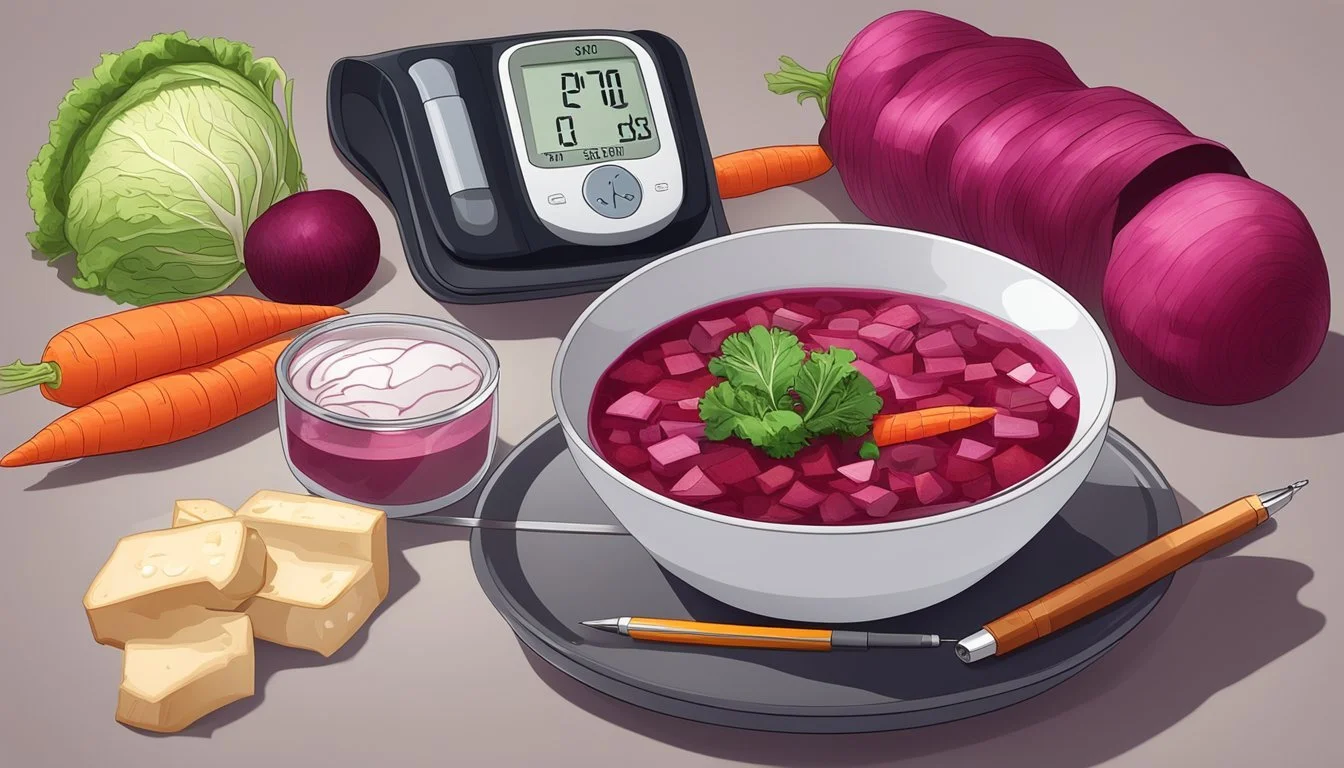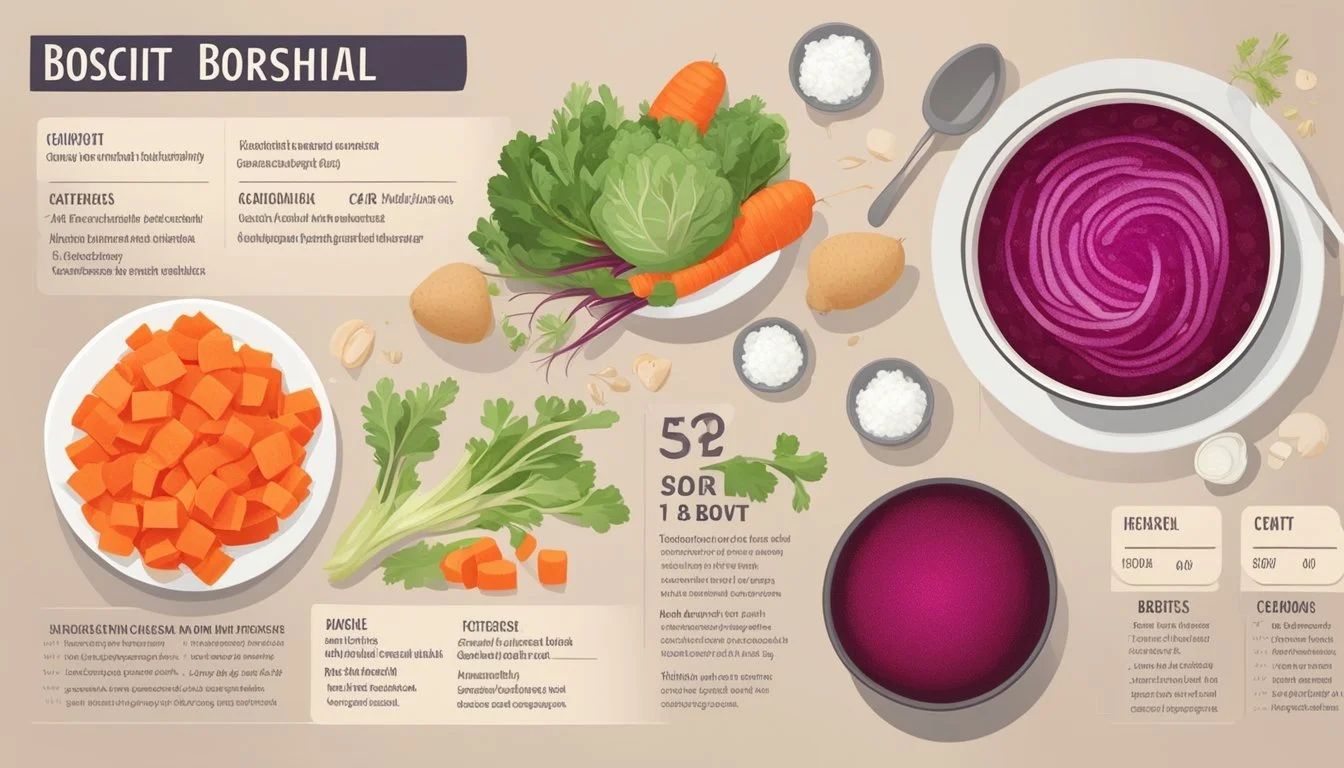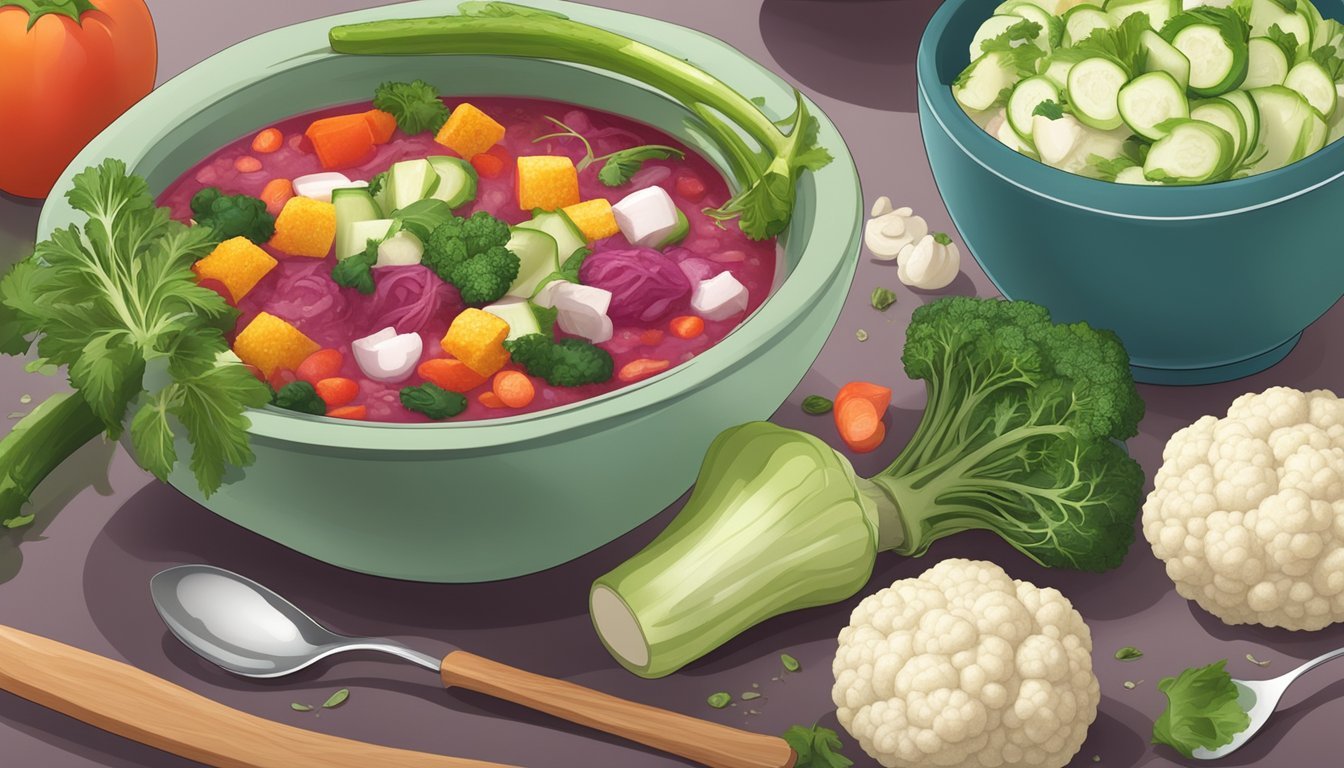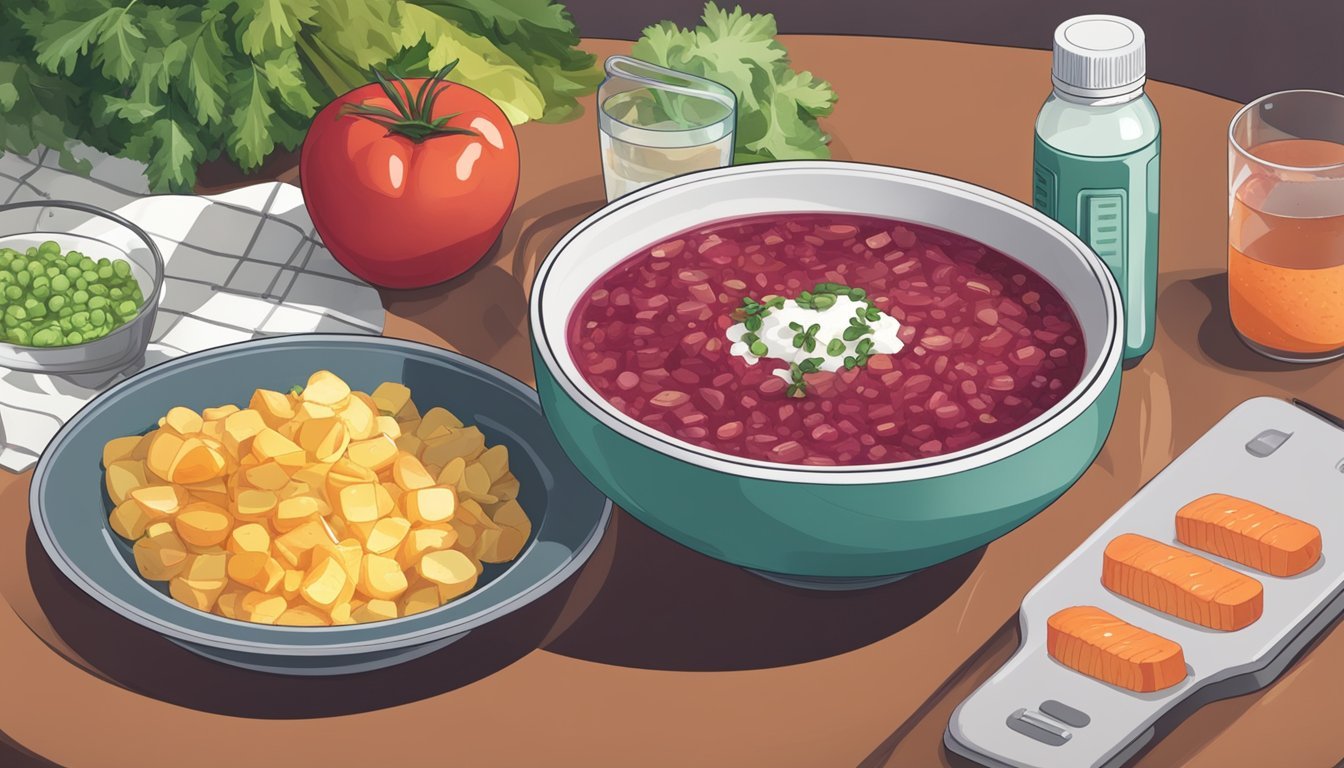Can Diabetics Eat Borscht?
Nutritional Insights and Guidance
For those managing diabetes, diet decisions are critical, and the question arises: can diabetics eat borscht? The good news is that borscht, when prepared thoughtfully, can indeed be a diabetes-friendly dish. This classic beet soup is not only rich in flavor but also offers various health benefits, particularly when using lean meats and fresh vegetables.
By focusing on ingredients such as beets, cabbage, and herbs like dill, borscht can be adapted to suit dietary needs. Beets, for example, are a noteworthy ingredient due to their relatively high fiber content and low glycemic index. These properties help stabilize blood sugar levels, making beets a suitable addition to a diabetic diet.
Moreover, by avoiding excessive salt, sugar, and using healthier fats such as margarine instead of butter, one can enjoy a delicious bowl of borscht without compromising their health. Adding a dollop of low-fat sour cream and plenty of vegetables enhances the nutritional value while keeping the dish delightful for everyone at the table.
Understanding Diabetes
Diabetes affects how the body regulates blood sugar levels and insulin. It is crucial to understand the role of insulin and one's diet in managing diabetes, especially Type 2 diabetes.
Blood Sugar Levels and Insulin
Blood sugar levels are regulated by a hormone called insulin. Insulin is produced by the pancreas and helps transport glucose from the bloodstream into cells, where it is used for energy. In those with diabetes, this process is impaired.
There are two main types of diabetes: Type 1 and Type 2.
Type 1 Diabetes: The body does not produce insulin.
Type 2 Diabetes: The body does not use insulin efficiently, known as insulin resistance.
Regular monitoring of blood sugar levels is vital for managing diabetes. The A1C level, a blood test, provides an average of blood sugar levels over the past two to three months. Keeping the A1C level within the target range can prevent complications.
Type 2 Diabetes and Diet
Proper diet is key to managing Type 2 diabetes. Foods must be chosen carefully to regulate blood sugar levels.
Low-Glycemic Foods: Foods like whole grains, legumes, and non-starchy vegetables help maintain stable blood sugar levels.
Fiber-Rich Foods: Foods high in fiber, such as fruits and vegetables, improve blood sugar control and promote heart health.
Portion Control: Controlling portion sizes helps prevent spikes in blood sugar levels.
Foods high in refined sugars and carbohydrates should be limited as they can cause rapid increases in blood sugar. Monitoring carbohydrate intake and balancing it with physical activity and medication ensures better control of Type 2 diabetes.
Nutritional Profile of Borscht
Borscht is a nutrient-rich soup that offers a variety of health benefits. It contains essential vitamins and minerals and provides key macronutrients. Understanding these elements is crucial for diabetics to make informed dietary choices.
Main Ingredients
Borscht primarily consists of beets, carrots, onions, cabbage, potatoes, and tomatoes.
Beets are rich in nitrates, antioxidants, and fiber, promoting heart health and digestion.
Carrots offer beta-carotene (Vitamin A), aiding vision and immune function.
Onions provide antioxidants and have anti-inflammatory properties.
Cabbage contributes Vitamins C and K, essential for immune health and blood clotting.
Potatoes add carbohydrates and essential minerals like potassium.
Tomatoes are a source of vitamins C and K, potassium, and antioxidants like lycopene.
Macronutrients and Micronutrients
Borscht supplies a balanced profile of macronutrients: fiber, protein, and fats.
Nutrient Function Fiber Aids digestion and helps regulate blood sugar. Protein Essential for tissue repair and muscle health. Fat Contains both saturated and unsaturated fats.
The soup is also rich in micronutrients:
Vitamins: A, C, K and several B vitamins, each playing roles in immune function, skin health, and energy metabolism.
Minerals: Potassium, magnesium, and iron which support heart health, muscle function, and oxygen transport.
Calories and Carbohydrates
The calorie content in borscht varies based on ingredients but generally falls between 70-150 calories per serving.
Calories: Provide energy required for daily activities but moderate consumption is essential.
The soup's carbohydrate content is influenced by root vegetables like beets and potatoes.
Carbohydrates: They are broken down into glucose, affecting blood sugar levels. The fiber content helps moderate this spike.
Sugar: Beets and carrots add natural sugars, which must be accounted for in diabetic meal planning.
This nutritional composition highlights borscht as a potentially diabetic-friendly dish, provided portion sizes and ingredient variations are managed carefully.
Health Implications for Diabetics
Borscht can be a beneficial dish for diabetics due to its low glycemic index, potential heart-health benefits, and anti-inflammatory properties. However, attention should be given to its impact on blood sugar, weight management, and sodium content.
Glycemic Index and Blood Sugar Impact
The glycemic index (GI) of borscht is relatively low, primarily due to its main ingredient, beets. This means that borscht is less likely to cause rapid spikes in blood sugar levels. Diabetics can benefit from foods with a low GI as they help maintain more stable blood sugar levels. Fiber content from ingredients like cabbage and beets also slows digestion, contributing to a slower absorption of sugars into the bloodstream.
However, it's important to avoid adding too many high-GI ingredients like potatoes or sugary vegetables. Balancing the overall meal with protein and healthy fats can further aid in stabilizing blood sugar levels after consumption.
Heart Health and Blood Pressure
Borscht's ingredients, particularly beets, are rich in nitrates, which can help lower blood pressure. Hypertension is a common concern for diabetics, and incorporating nitrate-rich foods may assist in reducing blood pressure levels. Additionally, beets are high in antioxidants like betalain, which can fight inflammation and oxidative stress, potentially lowering the risk of heart disease.
However, traditional borscht recipes often call for sodium-rich ingredients like broth or added salt. Diabetics should opt for low-sodium versions of these ingredients to avoid exacerbating blood pressure issues.
Weight Management
Weight management is crucial for diabetics, as maintaining a healthy body weight can improve blood sugar control. Borscht is typically low in calories while being nutrient-dense, making it a suitable option for those aiming for weight loss or weight maintenance.
The high fiber content from vegetables like beets and cabbage can promote satiety, reducing the likelihood of overeating. However, it's advisable to monitor portion sizes and avoid high-calorie additions such as large amounts of sour cream or fatty meats.
Anti-inflammatory Effects
Inflammation is a concern for diabetics due to its role in numerous complications, including heart disease. Borscht contains various anti-inflammatory ingredients. Beets, with their betalain content, are particularly effective in reducing inflammation. Other ingredients like garlic and carrots also possess anti-inflammatory properties, contributing to the dish's overall health benefits.
Consuming foods with known anti-inflammatory effects can support better long-term health outcomes for diabetics. This makes borscht a valuable addition to a diabetes-friendly diet, provided it's prepared with attention to sodium and calorie content.
Dietary Considerations and Alternatives
Borscht can be adapted to fit diabetic dietary needs without sacrificing flavor. Various modifications ensure it remains healthy while catering to specific preferences such as vegetarian, vegan, low-calorie, and low-carbohydrate diets.
Adapting Recipes for Diabetics
To make borscht suitable for diabetics, certain ingredients can be modified. For instance, using low-sodium broth instead of regular broth can help manage blood pressure.
Reducing or eliminating added sugar is essential; natural sweetness from beets and carrots can be sufficient. Incorporating lean meats like chicken instead of beef reduces fat content. For a vegetarian option, consider tofu or lentils.
Substitute sour cream with a dollop of low-fat yogurt or Greek yogurt, reducing calorie and fat intake while maintaining creaminess.
Low-Carbohydrate and Low-Calorie Variations
For those monitoring carbohydrate intake, vegetables like cauliflower can replace some of the higher-carb ingredients like potatoes. Using a smaller quantity of higher-carb vegetables like beets helps control the overall carb content.
Opting for olive oil instead of butter or margarine can lower calorie intake and provide healthier fats.
In a typical recipe, reducing high-calorie ingredients like sausage and using more low-calorie vegetables such as cabbage and zucchini will make the dish lighter. Adding more broth and fewer solid ingredients can also decrease the calorie density.
Vegetarian and Vegan Options
For vegetarian versions, eliminate meat and use vegetable broth instead of beef or chicken broth. High-protein ingredients like chickpeas or quinoa can add substance.
For a vegan borscht, ensure no dairy products are used. Replace sour cream with a dollop of cashew cream or coconut yogurt for creaminess.
Using olive oil instead of margarine ensures the dish remains vegan while also contributing healthy fats. Nutritional yeast can be added to provide a cheesy flavor without adding dairy.
By creatively altering ingredients, delicious diabetic-friendly variations of borscht can be made to suit different dietary needs.
Lifestyle Considerations Surrounding Diabetes
Managing diabetes effectively involves making mindful lifestyle adjustments that promote better overall health. Key areas of focus include maintaining regular physical activity and managing stress levels and sleep patterns.
Exercise and Physical Activity
Regular physical activity is crucial for individuals with diabetes. Exercise helps improve blood glucose levels, supports heart health, and aids in weight loss or maintenance. It enhances blood flow, helps manage nerve damage, and boosts overall well-being.
Types of Exercises:
Aerobic exercise: Brisk walking, swimming, or cycling.
Strength training: Weightlifting or resistance bands.
Recommendations:
Frequency: At least 150 minutes of moderate-intensity aerobic activity per week.
Combination: Include both aerobic and strength training activities.
Benefits for Diabetics:
Improved blood glucose control.
Reduced risk of cardiovascular diseases.
Enhanced insulin sensitivity.
Stress Management and Sleep
Effective stress management and adequate sleep are essential for managing diabetes. Chronic stress can affect blood sugar levels, while poor sleep can hinder diabetes control and increase the risk of complications.
Stress Management Techniques:
Mindfulness and meditation: These practices can reduce stress levels.
Physical activities: Exercise reduces stress hormones and improves mood.
Sleep Guidelines:
Duration: Aim for 7-9 hours of quality sleep per night.
Environment: Maintain a comfortable and quiet sleeping environment.
Benefits for Diabetics:
Better blood sugar stability.
Reduced risk of diabetes-related complications.
Enhanced mental and physical health.
Ensuring balanced lifestyle habits can significantly impact diabetes management and overall health.
Conclusion
Borscht can be a nutritious option for individuals with diabetes. The soup's primary ingredient, beets, is rich in vitamins A and C, iron, and fiber, which can support overall health without causing significant blood sugar spikes.
Including more vegetables like cabbage, carrots, and garlic in borscht enhances its nutritional profile. These ingredients are known for their low glycemic index and health benefits.
When preparing borscht for those with diabetes, it's important to control added sugar and salt. Opt for low-sodium broth and avoid unnecessary sweeteners to ensure the dish remains diabetes-friendly.
Sour cream, often used as a garnish, can be substituted with low-fat yogurt or omitted altogether to reduce fat content. This adjustment helps the soup align with dietary recommendations for individuals managing diabetes.
Enjoying borscht in moderation, as part of a balanced diet, can offer various health benefits. The high fiber content aids digestion, while the antioxidants in beets may reduce inflammation and support heart health.
To sum up, borscht, when prepared thoughtfully and enjoyed in reasonable portions, can be an excellent addition to a diabetes-friendly diet, providing both flavor and nutrition.
Ingredient Benefits for Diabetes Beets High in fiber, antioxidants Cabbage Low glycemic index, rich in nutrients Carrots Low glycemic index, vitamin A content Garlic Anti-inflammatory properties Low-fat yogurt Healthy alternative to sour cream
The careful selection of ingredients and mindful preparation can make borscht a valuable part of a diabetic meal plan.







